CAT Practice Test: September 8 - CAT MCQ
30 Questions MCQ Test Daily Test for CAT Preparation - CAT Practice Test: September 8
A monkey starts climbing a 15 feet tree. Each hour, he climbs 3 feet and rests for 30 minutes. During his rest, he slips back 2 feet. How many hours will the monkey take to reach the top?
A man covered a total distance of 1000 km in 16 hours, partly in a taxi at 36 km/hr and partly in a bus at 80 km/hr. The distance covered by the bus is
x, y and z are the three contestants in a kilometre race. If x can give y a start of 50 metres and x can also give z a start of 69 metres, then how many metres start can y give to z, if the race is supposed to end in a dead heat?
A train passes a 60 metres long platform in 20 seconds and passes a man standing on the platform in 16 seconds. The speed of the train is
In a flat race of L metres, A beats B by x1 metres and C by x3 metres. C will beat B, if
Two trains starting from the same station and travelling in opposite directions are 227.5 km apart in 3 hours 15 min. Had they been travelling in the same direction, they would have been 32.5 km apart in the same time. Find their speeds (in kmph).
Javed wanted to reach the ground floor of the building. He went down at the rate of 1 stair in 1 minute. 16 minutes after he started, Salma started from the same point, from where Javed stared, to reach the ground floor of the building. She went down at the rate of 2 stairs in 1 minute. In how many minutes did Salma overtake Javed?
A man standing inside a tunnel notices that Train A is running inside the tunnel with a speed of 45 kmph. Another Train B, which is half the length of Train A and coming from opposite direction, is running at a speed of 81 kmph. Train A passes Train B in 4 seconds. Which of the following is the closest approximation of the length of the tunnel, if Train A passes completely through it in 4 minutes?
A train of length 500 m crosses a platform in 50 sec and another train of the same length, moving in the opposite direction with double the speed of the first train, crosses a pole in 20 sec. What is the length of the platform?
Varun went for a long ride last Sunday. Every hour, he maintained a constant speed of 60 kmph. But after every 1 hour ride, he took rest for 10 minutes. If he starts from a place A at 8 a.m. and reaches a place B at 2 p.m. on the same day, what is the distance between A and B?
Two poles of height 6 m and 11 m stand vertically upright on a plane ground. If the distance between their foot is 12 m, find the distance between their tops.
Find the length of a chord that is at a distance of 12 cm from the centre of a circle of radius 13 cm.
In the given figure AB is the diameter of the circle and ∠PAB = 25°. Find ∠TPA.
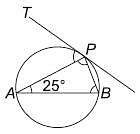
In the given figure, two straight lines PQ and RS intersect each other at O. If ∠SOT = 75°, find the value of a, b and c.
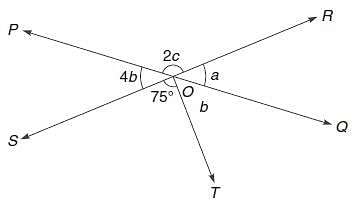
In the following figure, it is given that o is the centre of the circle and ∠AOC = 140°. Find ∠ABC.

Directions: This problem consists of a question followed by two statements numbered I and II given below it. Read the statements carefully and decide which of them is/are sufficient/necessary to answer the question.
Mark your answer as
a. if the data in statement I alone is sufficient to answer the question, while the data in statement II alone is not sufficient to answer the question
b. if the data in statement II alone is sufficient to answer the question, while the data in statement I alone is not sufficient to answer the question
c. if the data in either of the statements alone is sufficient to answer the question
d. if the data in both statements I and II together is not sufficient to answer the question
e. if the data in both statements I and II together is necessary to answer the question
Q. What is the code for 'eat' in the code language in which, 'he eat food everyday' is written as 'go pro rey kol'?
I. In that code language, 'everywhere food and eat' is written as 'pro wer nom kol'.
II. In that code language, 'he runs and walks daily' is written as 'gwt zat rey woc'.
Directions: This problem consists of a question followed by two statements numbered I and II given below it. Read the statements carefully and decide which of them is/are sufficient/necessary to answer the question.
Mark your answer as
a. if the data in statement I alone is sufficient to answer the question, while the data in statement II alone is not sufficient to answer the question
b. if the data in statement II alone is sufficient to answer the question, while the data in statement I alone is not sufficient to answer the question
c. if the data in either of the statements alone is sufficient to answer the question
d. if the data in both statements I and II together is not sufficient to answer the question
e. if the data in both statements I and II together is necessary to answer the question
Q. If 'qw tr yh pl' is the code for 'Let the game begin', then what is the code for 'begin'?
I. 'Begin working right now' is coded as 'pj tr se qa'.
II. 'Work begin tomorrow again' is coded as 'jh mn tr we'.
Directions: This problem consists of a question followed by two statements numbered I and II given below it. Read the statements carefully and decide which of them is/are sufficient/necessary to answer the question.
Q. Amit celebrates his birthday on 2nd October, 2018. How old will Amit be on that day?
I. Amit's 27th birthday was in 2007.
II. On his birthday in 2050, Amit would turn 70 years old.
Directions: In this problem, a question is given followed by two statements numbered I and II. Read the question and the statements carefully and decide which of the two statements is/are required to answer the question.
Q. There are five friends Ajhar, Bablu, Champu, Dharmesh and Ekam. Among them, who is the tallest?
Statements:
I. Dharmesh is taller than both Ajhar and Champu.
II. Bablu is shorter than Ekam, but taller than Dharmesh.
Directions: In this problem, a question is given followed by three statements numbered I, II and III. Read the statements carefully and decide which of them is/are sufficient/required to answer the question.
Q. What is the monthly salary of Ram?
I. Ram's basic salary is Rs. 500 more than Sita's basic salary.
II. Other allowances drawn by Sita, besides her basic salary, amount to Rs. 5000 per month, which is Rs. 1000 less than Ram's allowances.
III. Sita's basic salary is Rs. 15,000 per month.
Directions: The following problem contains a question and statements numbered I, II and III. Read the statements carefully and determine which of them is/are sufficient/required to answer the question.
Q. Persons X, Y and Z are sitting in a row facing the same direction. What is the position of X with respect to Y?
I. X is sitting at an extreme end of the row.
II. Z is sitting to the left of X.
III. Y is sitting in the middle of the row.
Directions: The following problem consists of a question followed by statements I, II and III. Read all the statements carefully and find out which of them is/are sufficient to answer the given question.
Q. What was the standing of team A in the tournament consisting of 5 teams, where each team had a different standing?
I. Team A finished above team B, but below team C.
II. Team A did not finish either at the extreme or in the exact middle.
III. There were exactly two teams between team A and team B.
Directions: The following problem has a question and three statements labelled I, II and III. You have to decide which of the following statements is/are sufficient to answer the question.
Q. In which direction is A with respect to the initial point?
I. A first walked 100 m in a straight line and then 50 m after taking a left turn.
II. A first walked in the East direction and then in the West direction.
III. A started moving towards North and travelled 100 m before taking right, and then travelled 50 m.
Directions: In this problem, a question is followed by two statements numbered I and II. You are to determine whether the data given in the statements is sufficient to answer the question. You should use the data and your knowledge of Mathematics to choose between the possible answers. Mark answer as
(a) if the question can be answered by using statement I alone, but cannot be answered by using statement II alone
(b) if the question can be answered by using statement II alone, but cannot be answered by using statement I alone
(c) if both statements I and II together are required to answer the question
(d) if the question can be answered by using either of the two statements alone
(e) if both the statements together are not sufficient to answer the question
Q. Find the largest possible two-digit number.
I. Sum of the digits of the number is a multiple of 15.
II. The difference between the original number and the number obtained on reversing the digits of the number is 9.
Directions: The question below is followed by statements I and II. You are to determine whether the data given in the statements is sufficient to answer the question. You should use the data and your knowledge of Mathematics to choose between the possible answers. Give answer
(a) if the question can be answered by using statement I alone but cannot be answered by statement II alone
(b) if the question can be answered by using statement II alone but cannot be answered by statement I alone
(c) if both statements I and II together are required to answer the question
(d) if the answer can be found by using any of the two statements alone
(e) if both the statements together are not sufficient to answer the question
Q. Find the numbers, if
I. average of the 3 numbers is 29.
II. two of the three numbers are in the ratio 5 : 7 and the other number, when divided by 5, leaves remainder 2.
|
152 docs|327 tests
|



 ........ (1)
........ (1)
 = 54 kmph
= 54 kmph


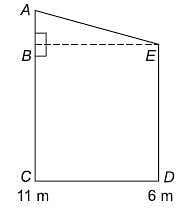
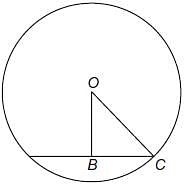
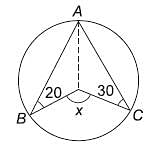
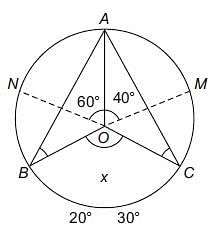
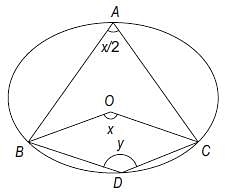
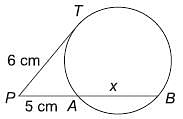
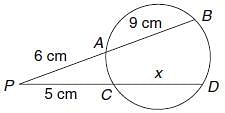
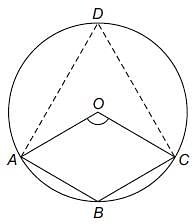

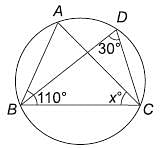
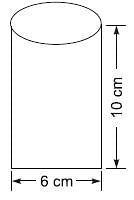
 3 = 87 → Not sufficient
3 = 87 → Not sufficient 3 = 87, still no number can be found → Not sufficient
3 = 87, still no number can be found → Not sufficient














